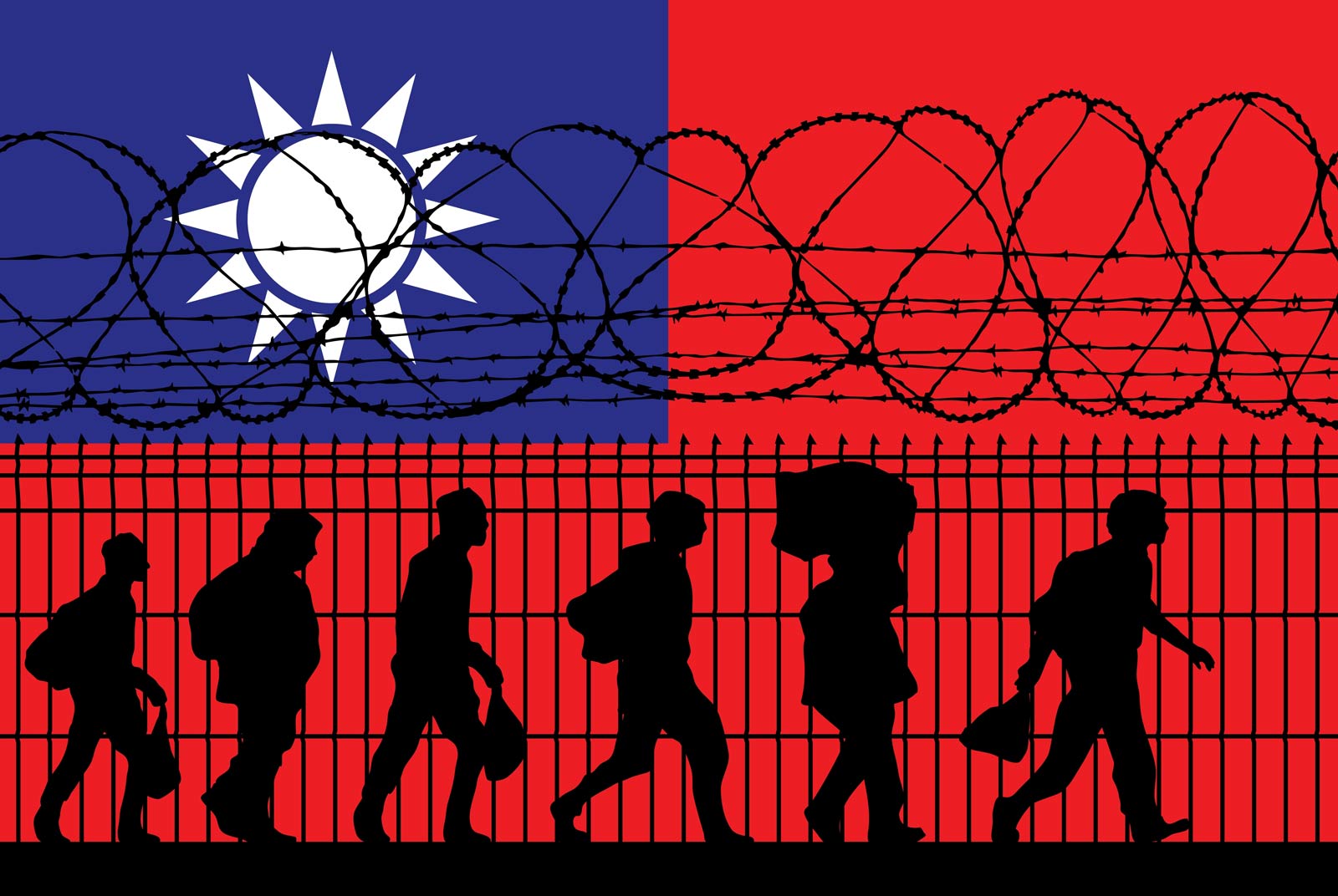Taiwan needs a dedicated government department for its multifaceted immigration challenges

Source:shutterstock
In this op-ed, David Stinson shares his opinion about how Taiwan needs to transition from keeping migrants out to proactively attracting them while also addressing the issue of migrant worker exploitation and considering new source countries like India.
Views
Taiwan needs a dedicated government department for its multifaceted immigration challenges
By David Stinsonweb only
Few countries put much effort into formulating long-term immigration plans. In most cases, the global pool of potential immigrants is so immense, and the market demands sufficiently short-term, that immigration can be safely considered a distant second policy priority to issues like national defense and business environment.
Taiwan is not like most countries. It faces an immense challenge from demographic aging, currently unprecedented in an industrial country, although the crisis will be broadly matched by countries like South Korea and China when it arrives. (In Japan, the original poster child of depopulation, the population crash started decades earlier than in Taiwan, but Japan now has the highest fertility rate in East Asia.)
Taiwan needs to transition relatively quickly from a stance of keeping migrants out to proactively attracting them.
If that were not enough, however, the nation also faces an existential security threat which involves precisely the question of identity. Its migrant worker program has so far avoided scrutiny as Taiwan basks in international media attention, but it is still a latent risk. If citizens of the US and other countries are at some point asked to make real sacrifices on Taiwan’s behalf, much tougher questions could be asked. The government needs to get ahead of this narrative, yet it is a complex issue involving the foundations of Taiwan’s entire economic model.
Outsourced law enforcement
One important difference between the immigration debate in Taiwan and in many other countries is that people are already onshore, working legally. The most important question for the foreseeable future is therefore not about bringing new people to Taiwan, but rather how Taiwan can ensure that existing migrants are able to fully participate in the economy, becoming consumers and later even investors (calling them “workers” implies that they only have one role in the economy). Native workers should expect to see their salaries increase from this process, rather than decrease.
Read more: From migrant workers to immigrants: Taiwan’s solution to the declining population
Thus, it would instead be employers who would more likely object to regularization of migrant workers. A program to directly increase wages across the board, paid out of profits, is dead on arrival. Instead, an immigration strategy should focus on deeper reforms with a light touch. One key target could be the brokerage system for migrant labor.
Brokers play a variety of roles from staffing agency to immigration consultant, translator, and vocational school. That is why even some smaller-scale attempts to provide an optional alternative pathway to employment have failed to attract employer interest. It might seem that such efforts are doomed to failure, if Korea had not already succeeded in creating a migrant labor system without brokers. Korea partners with the source countries to screen potential migrants before they come onshore; then once applicants pass a test, they can be directly hired.
Middlemen do play various roles in many well-functioning markets, so their mere presence does not indicate a market failure, but international labor migration is one of the areas of greatest state involvement in the economy. This type of service should be provided directly by the government, to the extent it is needed at all.
One particularly important market distortion comes from the requirement for workers to obtain permission or pay large fees to brokers before changing jobs, under threat of deportation. This arrangement not only leaves employees with close to zero bargaining power, but also effectively creates a shadow system of law in which the government might have one set of immigration rules, but middlemen can enforce a second set of unwritten rules, guided by cost reduction rather than national priorities. More insidiously, in the longer term, this system also fails to reward employers which make the effort to move up the value chain and provide better employment conditions.
The government cannot directly tell low-value companies with an older mindset to either reform or go out of business – but neither should it protect them. Labor mobility based on direct bargaining provides a sound middle ground, pointing to a future economic model without necessarily imposing it. This will be a long-term, but necessary effort if Taiwan is to rebalance its export structure away from China amid a global environment of protectionism and deglobalization.
Haphazard planning
Because so much of the politics of immigration involves questions of cultural identity, it is also worth thinking deeply about source countries.
In the past, immigration was based around the notion of huaren, a larger Chinese diaspora around the region, and it also focused on family migration – notwithstanding the social stigma of ‘bride shopping.’ Later, economic migration expanded Taiwan’s source countries to also include the Philippines and Indonesia, which lack deep connections to Chinese culture, while still leaving few pathways to become Taiwanese.
Read more: The Mother I Never Got to Say Goodbye to
Under the New Southbound Policy, these source countries also started to be recognized for their foreign policy value, yet one country was always left out of this thinking. Last month, according to UN statistics, India overtook China to become the most populous country in the world, a milestone whose implications will reverberate for decades.
In the wake of the Ukraine war, India has staked out a role as a global ‘swing voter’ between the emerging Chinese and US blocs. In addition to being a New Southbound member, it was also a key country in the “Indo-Pacific” concept of former Japanese Prime Minister Shinzo Abe, which was later adopted by the US.
As such, Taiwan has made increasing efforts over the past several years to deepen bilateral ties with India. These efforts remain tepid, however, and mostly limited to the diplomatic level, aside from a few flagship technology investments in India. People-to-people ties have been severely neglected on the Taiwanese side. There are currently fewer than 5,000 Indian residents in Taiwan. Is there a good reason for the difference of some forty times with Indonesian migrants, or was that simply an accident of history?
It is important to note that several of Taiwan’s immigration source countries with stronger Chinese heritage are experiencing population shortfalls of their own, as well as economic booms which might make people less willing to move. Taiwan meanwhile also has several larger rivals in the migrant labor space. Japan and Korea are also competing for the same population pools.
The biggest unknowable however is China, whose shortfall over the next few decades would be large enough to easily swallow Taiwan whole. China has not yet imported workers at a large scale, but any attempt to do so would have far-reaching effects. In any case, it is no longer contributing migrants to Taiwan, Japan, and Korea as it has in the past, creating a net regional deficit.
An economy as diverse as India is bound to contain niches complementary to Taiwan’s economy. In theory, its tech sector could complement Taiwan’s comparative disadvantage in software, helping alleviate the constant brain drain into hardware. The cultural differences between the two countries seem immense, but this is precisely why a pilot-scale effort could be useful in identifying new opportunities, and perhaps creating new communities.
Taiwan will need to develop a scarcity mindset towards labor markets, valuing the needs of both employees and employers. Apart from manual laborers, Taiwan does aim to recruit a small number of global “elites” through its Gold Card program, but this segment usually exceeds the budgets of local companies. Going forward, the government will need to be more conscious about using immigration to shape a robust middle class.
Read more: Low pay drives 40% of ‘Gold Card’ expats to leave Taiwan
People are policy
The Taiwanese government is broadly aware of the consequences of an aging demographic, but is moving too slowly. The National Development Council oversees overall economic planning and has been studying these issues with increasing vigor over the past few years. Last year, it announced a goal to recruit 400,000 net new migrants by 2030, and it also finally unveiled a pathway to citizenship for migrant workers, although less than a third currently qualify.
Immigration itself is an Agency (shu;署) housed under the Ministry of the Interior, which gives it the power to enforce laws, but not to formulate broad strategies on the level of a Ministry (bu;部) like Foreign Affairs. Its status could be changed quickly with legislation, just like the newly established Ministry of Digital Affairs, bringing all relevant capabilities under one office. Doing so would enable thinking on the generational timeframe required to properly plan population issues, while giving politicians a degree of insulation in order to quietly implement a transformational vision.
The National Immigration Agency is currently coming out with a new immigration and demographics policy in cooperation with the Executive Yuan. It will probably contain good ideas, but still approach the problem from a reactive rather than proactive stance, and not contain any structural changes.
The form of a government represents its priorities. Anybody can see the coming situation with Taiwan’s demographics, yet the reality is that no politician runs for office with a spreadsheet in hand. Arguably, that is not their job. None of this is a problem unless they also lack the sense to let others do their jobs. Fortunately, immigration is not an object of hopeless partisan division in Taiwan, unlike in the US or the EU – or with certain other issues in Taiwanese politics.Rather, iIt is simply the object of broad-based apathy.
A regional and even global demographic scramble is coming. As with any resource competition, sitting out the first round will only create greater disadvantages down the line.
(This piece reflects the author's opinion, and does not represent the opinion of CommonWealth Magazine.)
About the author:

David Stinson is a researcher at the Taiwan Academy of Banking and Finance (TABF) specializing in macroeconomics and geopolitics. The views expressed are those of the author only.
Have you read?
- The Mother I Never Got to Say Goodbye to
- From migrant workers to immigrants: Taiwan’s solution to the declining population
- Low pay drives 40% of ‘Gold Card’ expats to leave Taiwan
Uploaded by Ian Huang






